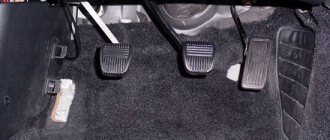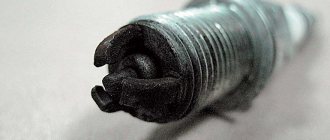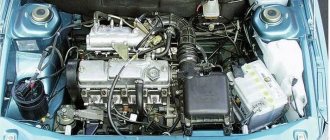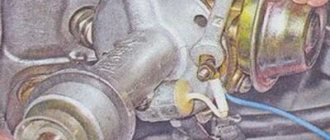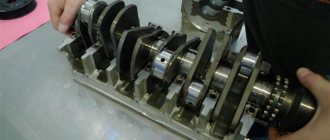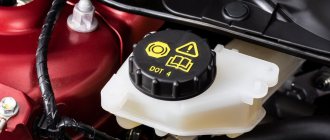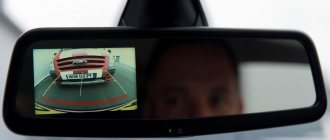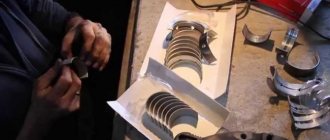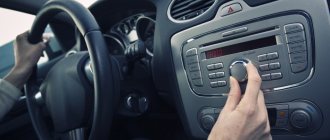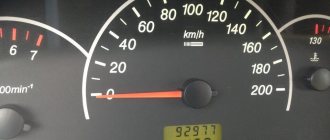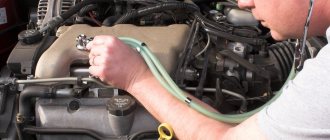Foggy headlight
The fogging is so strong that it does not even allow you to determine the type of headlight.
The fogging is so strong that it does not even allow you to determine the type of headlight.
Generally speaking, absolutely all headlights and other car lights are a priori leaky. It cannot be otherwise: when heated, the temperature inside any headlight can easily change by 100 degrees! From minus 35, achievable in winter even in central Russia, to 60–70 degrees with the headlights on in the summer, in the sun. In addition, the rear part of the headlight is located in the engine compartment, where, as a rule, it is quite hot. At the same time, the air in the headlight naturally expands, and therefore cannot be avoided without exchange with the external environment.
Where there is contact, there is always the possibility of fogging. For example, if a cooling headlight sucks in moist air - say, at a car wash, then the transparent cap (previously it was a diffuser) according to the laws of physics has the right to become somewhat cloudy. Well, if the headlight has defects, then it has a much higher chance of fogging up. The once beloved Volga of one of the authors began to attract attention because the headlight glasses behaved differently - one was more transparent than the other. Soon everything became clear: during a visit to the service, one diffuser fell off by itself!
Is fogging dangerous? Without a doubt. It distorts the light distribution, which disturbs both the driver (the illumination of the road decreases) and other road users (it blinds them).
Consequences of optics fogging
They won't keep you waiting long:
- reflectors, lenses or unit adjustment mechanisms will be damaged;
- internal gaskets will collapse;
- perspiration will disrupt the centering of the light beam and reduce the illumination of the road surface;
- a lens effect is formed, leading to light refraction;
- the performance of electrical parts will deteriorate;
- Contacts will oxidize and wires will break.
If the headlights sweat, it is recommended not to turn on the optics until they are completely dry. The power connectors must be immediately disconnected to protect against breakdowns. Gas-discharge lights are especially dangerous in terms of short circuits.
Cloudy headlight
The low beam of Largus's headlights is greatly distorted.
The low beam of Largus's headlights is greatly distorted.
At the same time, increased humidity inside the headlight housing destroys the coating of the reflectors. Well, there’s nothing to say about electrics: water and contacts will never make peace.
If the headlight is working properly, then, in general, there is nothing to be afraid of. The fogging will disappear as quickly as it appeared. The headlight, as we already mentioned, in cheap designs there is a tube directed downward, while more modern cars use special breathers with small filters for ventilation.
How to get rid of foggy headlights
First of all, you need to remove the moisture accumulated inside. To do this, the headlight is disassembled and dried.
More details on how to do this:
- remove the headlight covers;
- turn on the low beam for 2–3 minutes;
- leave the car like this for 1-2 days.
The heat generated by the light bulb and the air will dry out the internal cavity of the optics. But this method has a drawback - the battery will quickly run out and will have to be recharged. In addition, the car must be in a warm and clean garage.
A more effective way is to direct a stream of air inside the housing using a hairdryer or compressor. 15–20 minutes of this procedure will be enough for all the moisture to evaporate. But here it is important not to overdo it with the air temperature - an overly hot jet can damage the reflector or glass.
Drying headlights with a hairdryer
Option three is to completely disassemble and remove the headlight. Take it home and dry it in a room where the heating is on. If it’s summer, you can put the block on the balcony, under the roof. However, not all flashlight models are easy to remove. Therefore, this method is suitable for optics that are mounted on several bolts or latches.
Of course, drying the headlights alone will not solve the fogging problem. The main thing is to find and eliminate the cause. Otherwise everything will happen again. As was written above, this can be caused by clogged drainage holes, damage to glass or seals.
There are also a few tricks that will help eliminate fogging:
- turn off the headlights a few minutes before washing the car - give the bulbs time to cool;
- put several bags of silica gel inside the cover of the optical unit - this substance absorbs moisture well (for example, Kia and other manufacturers regularly install silica gel in their products);
- Clean the ventilation openings regularly to prevent blockages and prevent fogging of the lights.
There are also cars on which the ventilation valves have not been modified from the factory. Dealers may not recognize this fact, which entails problems for the owner. Now he himself must decide the issue of eliminating fogging.
Popular brands:
Kia Rio, Toyota Land Cruiser, Volkswagen Touareg
headlight
Fog light Kia cee'd.
Two breathers are clearly visible. One for each section. Fog light Kia cee'd. Two breathers are clearly visible. One for each section.
What faults can cause fogging? Everything is simple here: most often the ventilation is simply clogged with dirt. Headlights with cracks also “walk on their own.” Some cases of fogging are associated with unprofessional disassembly/assembly of the headlight.
In such cases, there is only one piece of advice. Repair the headlight until all joints are sealed, so that only the standard “breathers” remain. If this does not work, the headlight must be replaced. No desiccant in the form of silica gel or pieces of diaper will help a faulty headlight.
And yet, how dangerous are drops of water caught in a headlight? We carried out a simple experiment: using a syringe we pumped 20 ml of water into the optics of the editorial Largus - this is quite a lot. We turned on the headlights, waited, then turned them off - well, yes, the hubcaps became cloudy. The light distribution became ugly. However, after a couple of days, after a relatively short run, the effect disappeared: the water safely evaporated into the atmosphere. Which, in fact, was what needed to be proven.
Of the useful tips regarding anti-fogging, we will mention, perhaps, only one: be careful when washing the engine compartment under pressure. A strong jet can rip off the “breathing caps” and cause trouble, after which you will have to seriously tinker with the headlight or replace it altogether.
Reasons and what to do when headlights fog up
Some motorists often have no idea why their headlights sweat. More experienced drivers will say - due to temperature changes. And there are actually several reasons.
- Clogged drain valves. The light bulb heats up during operation, then cools down. All this creates internal pressure, but the manufacturers took this factor into account and therefore equipped the design with special exhaust and supply channels. However, over time they become clogged, and then the headlights fog up. In addition, when the air outside is too humid, condensation can form even on optics with fully functional valves. On many vehicles, drain holes come in the form of simple plastic caps or curved tubes with foam inserts. Check if there is any mechanical damage, then either clean the channels or replace the foam with new one.
- Cracks in the glass. For the headlight to work properly, the glass must be completely sealed. If the surface of the optics is cracked, the seal is broken and this leads to various problems. For example, rain or snow moisture penetrates through a crack, accumulates inside and begins to release condensation. The solution is to replace the block or glass, making sure to dry the internal cavity first.
- Destruction of seals. This often happens on used cars whose owners do not regularly monitor the technical condition of the optics. The rubber elements, which are designed to seal the optics unit, become outdated and begin to let moisture through. The sealant on which the seals are placed also dries. Fixing this malfunction is simple - you need to dry the headlight from the inside and replace the seals, placing them on a new layer of sealant.
- The hydraulic corrector breaks. This is a device with which the driver can adjust the headlights. There is a special liquid in the body of the device - when it rolls in one direction, the pressure and intensity of the light beam changes. The hydraulic corrector is controlled from inside the car using a knob on the instrument panel. Over time, the body of the element may crack, and then the liquid pours into the internal cavity, which causes fogging. The problem is solved by repair.
Interesting moment! All car headlights have the ability to “breathe” - in other words, emit steam. If the condensation disappears half an hour after turning on the lamps, then everything is normal and nothing needs to be done.
I had a problem - after a small accident, the mount on the headlight on top broke. The guys at the service station soldered the part, but then discovered that the lamp began to fog up - there were broken fasteners where the glass snaps to the base. I took off the flashlight, took it home and dried it on the battery for 24 hours. Then I covered all the joints and cracks with transparent sealant. I've been driving for about a month now without any problems. Maxim, motorist, Orel city
Chevrolet Cobalt
The breathers of the Chevrolet Cobalt are sealed with blue non-woven material to prevent dust from entering.
The breathers of the Chevrolet Cobalt are sealed with blue non-woven material to prevent dust from entering.
Tell us in the comments if you have ever encountered fogging of lighting devices and how you dealt with this phenomenon.
Foggy headlight: treat or replace?
How to disassemble and reassemble optics to eliminate condensation from the inside
To most effectively get rid of condensation, it is advisable to remove and disassemble the headlight. This is done according to the following instructions:
- Remove the headlight block. Separate the turn signal from the lamp and unclip the back cover. Check the inside of the cover - there should be no noticeable cracks, chips, or scratches. Pay special attention to the gasket. If it is not soft, does not fit well and does not provide a tight seal, then it should be replaced;
- Remove the glass by pressing the six latches with pliers. Check the gap between the glass and the gasket - this is where water often penetrates;
- Separate the gasket placed around the entire perimeter of the headlight. It should not be hard or stiff. The area underneath is clean, free of dirt, leaves and other debris. The rubber fits tightly on the headlight body and seals the edges well;
- Remove the high/low lamps and the marker. Clean the copper pins where the wires are inserted from dirt and oxides. It wouldn't hurt to clean the terminals of the common connector as well. The reflector can be successfully cleaned of dirt and condensation residues using a chemical glass cleaner (dirt is visible as a white coating); you will also need a soft makeup brush. You must work as carefully as possible so that the spray layer does not come off;
- Remove the lamp reflector caps. A lot of soot and moisture collect inside them; this must be cleaned out.
Proper cleaning and assembly
At the final stage, blow the surface of the reflector with hot air. Wash the glass and dry thoroughly with a cloth. Replace the problematic seal with a new one. Be sure to wash and dry the seat of the rubber cuff. Place the gasket on the sealant so that after drying there is no room left for moisture to seep through. It is also recommended to apply silicone over the rubber to seal the now seam between the glass and the headlight.
What to do with foggy car optics? And should we pay attention to this?
Foggy headlight: treat or replace?What can happen if you don’t do anything and don’t keep things clean?
If the headlight constantly fogs up, this may indicate that condensation is accumulating and “creating a lens effect.” This leads to the fact that the rays are refracted passing through the drops and scattered. The light becomes dim and its range decreases, making driving at night more difficult.
- Water can oxidize electronics and damage the lighting system.
- If H2O gets on a heated reflector, this will lead to its gradual degradation and corrosion, resulting in destruction.
Due to moisture, the contact oxidizes and the internal electronics become unusable!
Why do car headlights sweat from the inside?
The headlight often fogs up in humid weather or after a car wash. Moreover, this phenomenon does not depend on the mileage of the car; the headlights inside can be damp even on a practically new car. A car headlight (tail light) is a closed space in which, as the temperature from the incandescent lamp increases, the internal pressure also increases. To prevent excess pressure from being created, all automotive optics have special valves.
The purpose of the valves is to let air in and out of the optics, but dust, dirt and water should not fly into it. In the evening after a trip in the off-season, the headlight cools down, the pressure in it decreases, and moist air enters through the valve. Moisture condenses on the glass, causing the optics to fog up. There is nothing wrong with this if the moisture quickly evaporates after the car warms up and starts moving. But condensation does not always go away, and then it already causes a lot of problems for the car owner. The most common cause of the defect is caps falling off the ventilation valves; in this case, the optics require repair. Also, moisture can penetrate into the headlight through a barely noticeable crack in the glass or in the housing - if condensation lingers in the optics for a long time, it must be repaired.
How to check where the depressurization is
To determine where the design allows excess to pass through, you need to remove the part from the transport, fill a bath and place the optics there. Then we observe the object. If the air goes up in the form of bubbles, then determine the source where it comes from, mark it in a convenient way, and then seal the place with sealant. After the substance has dried, apply a second coat to ensure reliability and improve the quality of the work done.
Depressurization of the structure will lead to the fact that after washing the car, water will seep into the optics, during operation the device will heat up and fog will form inside.
